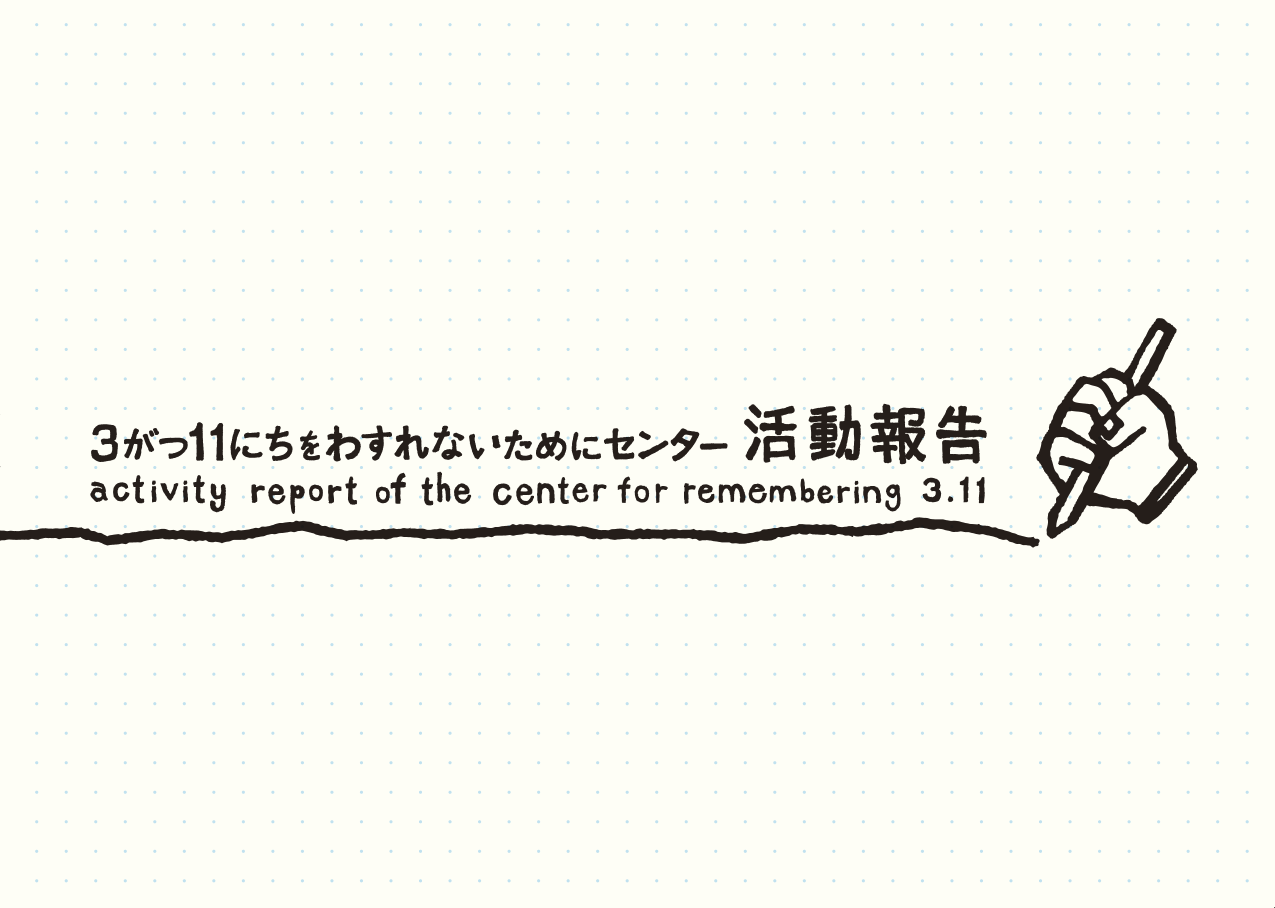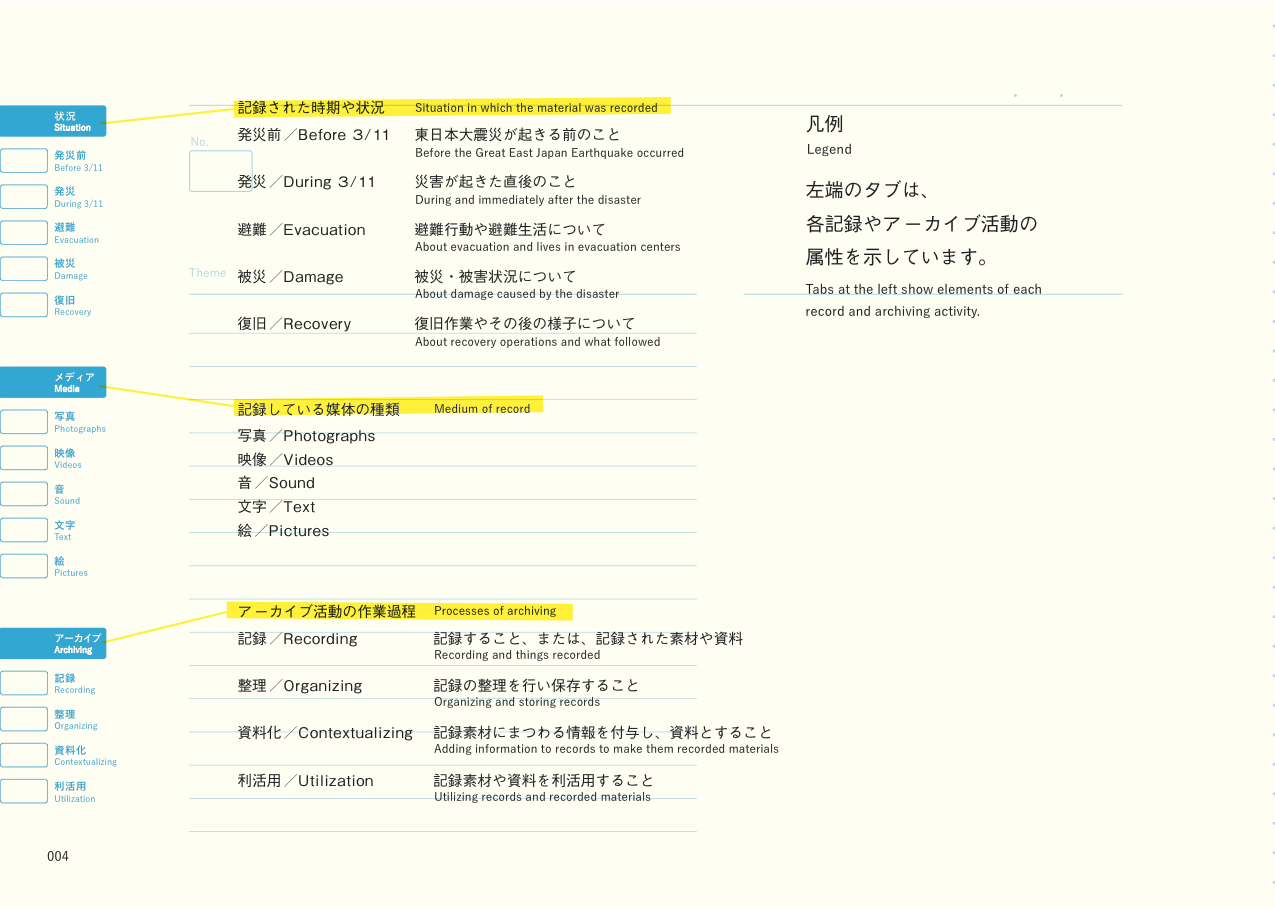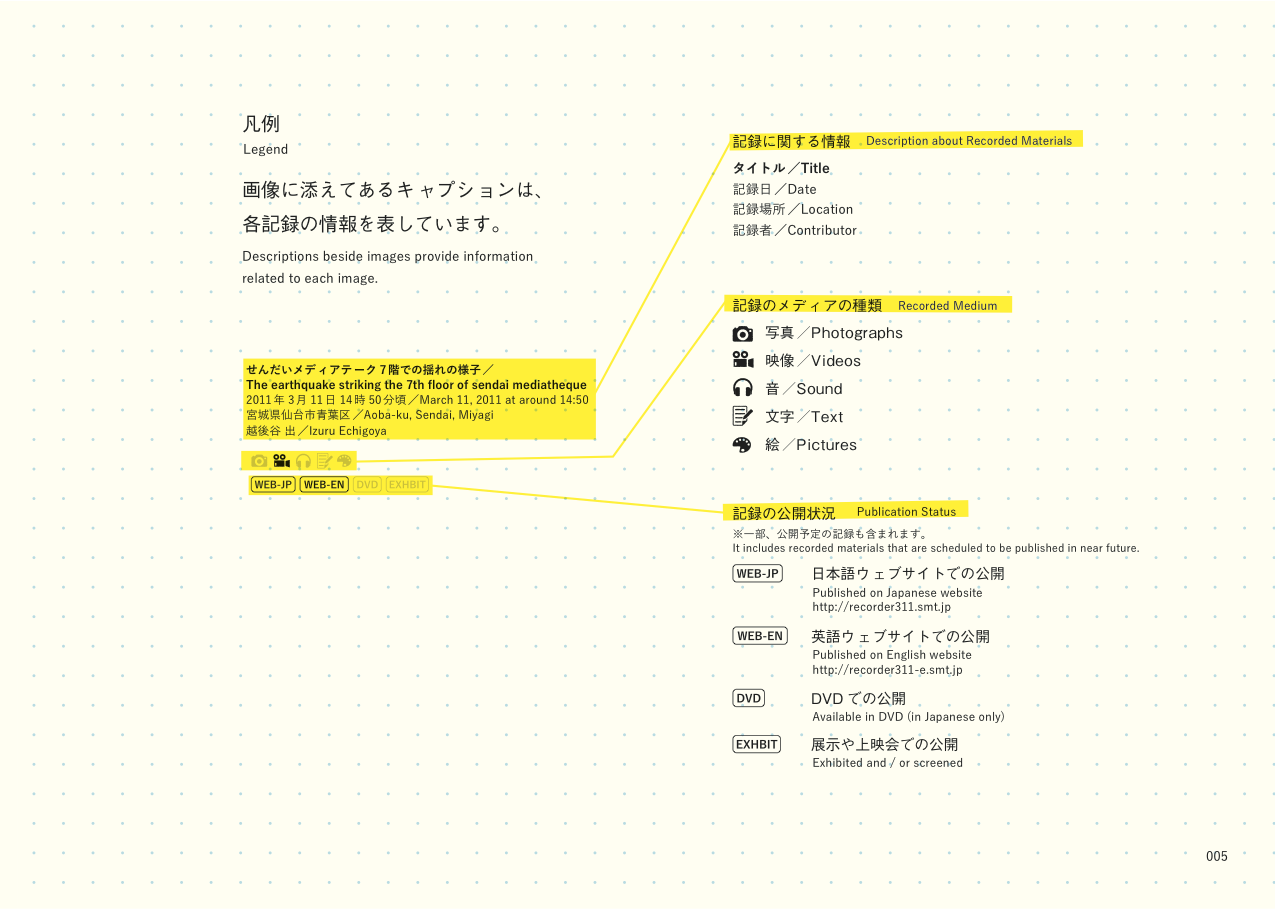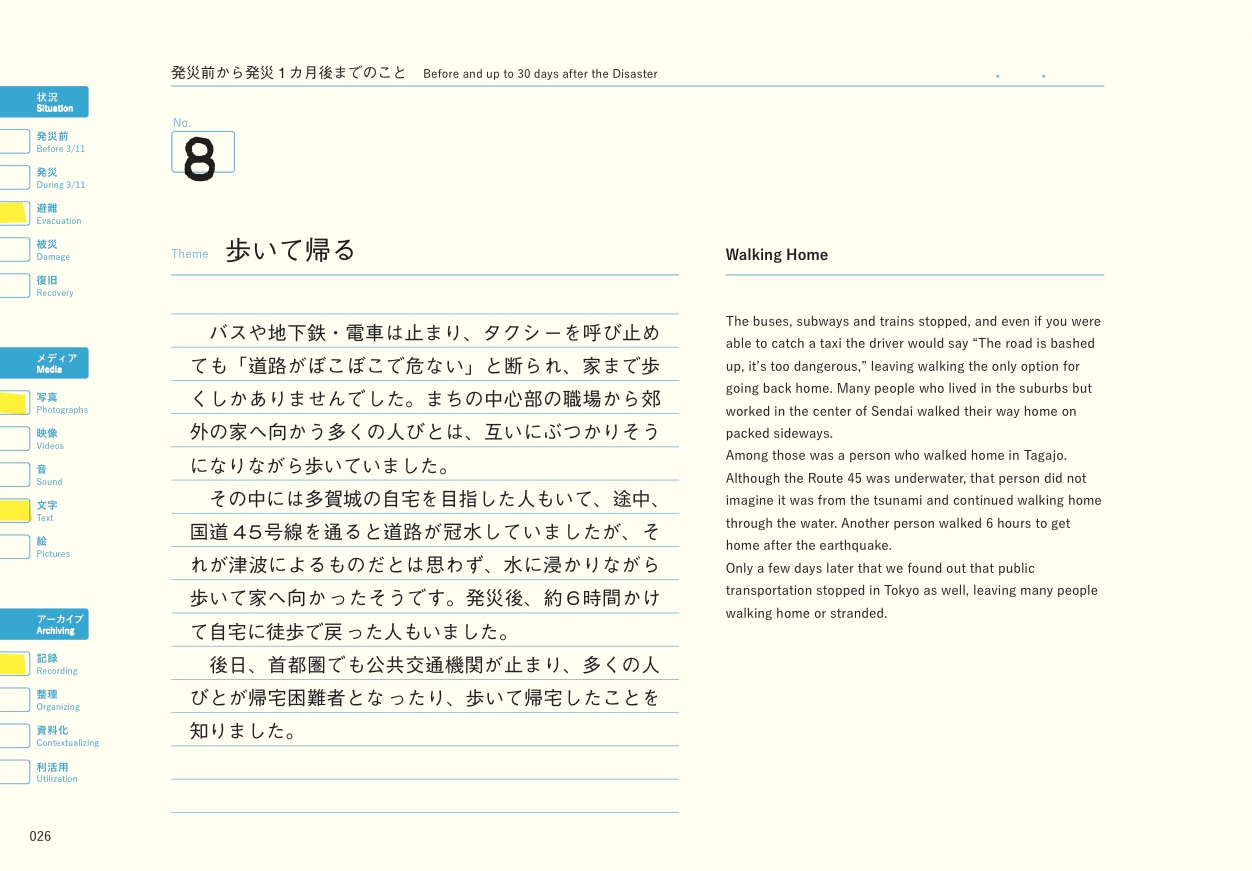Activity Report of the Center for Remembering 3.11
We are pleased to announce the release of "The Activity Report of the Center for Remembering 3.11" (originally published in February 2015) on the web. In this report, we introduced our activities and records over the four years since the Center for Remembering 3.11 opened.
Please download the activity report of the center for remembering 3.11 (pdf / 15MB) from here.
Introduction
This book aims to convey images of the Great East Japan Earthquake perceived through recorded materials contributed to “the center for remembering 3.11,” as well as activity of archiving itself.
It features 45 themes in four sections, which are structured with elements such as things that can be read from recorded materials, experience gained from archiving activities and experience of going through the disasters from a variety of people.
Legend
About the center for remembering 3.11
Before and up to 30 Days after the Disaster
| 1 | Everyday Scenes</strong | p.010 |
| 2 | Foreshock | p.012 |
| 3 | Respective 3/11 | p.014 |
| 4 | Confusion after the Tremor | p.016 |
| 5 | To a Safer Place | p.018 |
| 6 | To a Higher Place | p.020 |
| 7 | Snow | p.024 |
| 8 | Walking Home | p.026 |
| 9 | The Starry Sky | p.028 |
| 10 | The Following Morning | p.030 |
| 11 | Living | p.032 |
| 12 | Another Earthquake | p.036 |
| 13 | Cherry Blossoms | p.038 |
Photographs, texts and sound-recordings as well as their making
| 14 | Re-coding from the Same Perspective | p.042 |
| 15 | Legends | p.046 |
| 16 | Stone Monuments | p.048 |
| 17 | Notices | p.050 |
| 18 | Personal Notes | p.052 |
| 19 | Drawing with Hearing | p.054 |
| 20 | View with Ears | p.056 |
| 21 | Voices for Reconstruction | p.058 |
Moving Images and Their Making
| 22 | Everyday and Video Camera | p.062 |
| 23 | Motivation for Recording | p.066 |
| 24 | First Video Camera | p.068 |
| 25 | Broadcasting Records | p.070 |
| 26 | Putting it in Words | p.072 |
| 27 | More than Words | p.074 |
| 28 | Support Activities | p.076 |
| 29 | Recovery Operations | p.078 |
| 30 | Records of Residences | p.080 |
| 31 | Records of Culture | p.082 |
| 32 | Records of Meetings | p.084 |
| 33 | Another Perspective | p.086 |
| 34 | Thoughts Caused by Landscapes | p.088 |
| 35 | Witnessing Dialogues | p.092 |
| 36 | Facing Loss | p.094 |
Practices of Contextualizing and Utilization in Archiving Activities
| 37 | Screenings and DVDs | p.098 |
| 38 | Opportunity to Talk | p.100 |
| 39 | From Data to Tool | p.102 |
| 40 | Invisible Things | p.104 |
| 41 | First Meal | p.106 |
| 42 | Coastal Culture in Folklore | p.108 |
| 43 | Opportunity for Records and Recollections | p.110 |
| 44 | Studying the Disasters | p.112 |
| 45 | Website | p.114 |
In Conclusion
In order to convey the general outline of our archiving activities ̶recorder311, this booklet introduces selected contributions and activities we practiced. They are introduced in four sections; the first section presents them in chronological order, while the second and third sections are segmented by type of recording and content. The last section is organized along working processes of archiving activity.
In the enormous scale of the Great East Japan Earthquake, what our recordings show is only a tiny fraction. Yet however small they may be, they are firsthand fragments of the disaster that each one of us have experienced, seen and heard since March 11, 2011 up to the present, as well as the achievements of their attempt to pass them down to future generations.
In response to the Great East Japan Earthquake, there have been many different “disaster archiving” activities, conducted by various groups in various places. As goal, concept and methodology differ from group to group, the meaning of the word “archiving” slightly differs in each activity.
As for recorder311, when we speak of “archiving” we mean a series of collaborative activities that consists of “recording & collecting,” “organizing & storing,” “contextualizing,” and “utilizing,” through which our recordings activities are nurtured into “tools” to pass down the achievements to the future generations, sharing them with many different people and places.
In more concrete terms about recorder311’s concept, it gathers people who agree with its goal of making the recordings public and leaving them for posterity. They are the main group of people who do “recording & collecting” as “contributors,” sharing those recordings with In Conclusionrecorder311. It in turn “organizes & stores” them to be “contextualized” and “utilized” with the contributors and citizens, nurturing them into “tools.” Furthermore, in all of those processes, essential are
interactions with supporters, donors and audience.
At the beginning, recorder311 had not imagined the current dynamic situation in which diverse people gather around the archiving activities, taking part in them in a variety of ways. However, while groping for significance of our activities, little by little we came to the
understanding that the core of a community archiving activity is to provide opportunities and systems with which recordings are returned to each person’s everyday life, for even though they are recordings of a disaster, they fundamentally are recordings of one’s life. That is how recorder311 has grown to an “archive” at it is now, being sustained by multi-layered and circulating people.
For that reason, contributors in recorder311 are essential in every phase of archiving; from the act of recording ̶ the “seed” ̶ to the act of utilization for others and future generations ̶ the “fruit.”
As last year marked the 10th anniversary of the Mid Niigata Prefecture Earthquake in 2004, and January this year marked the 20th anniversary of the Great Hanshin-Awaji Earthquake in 1995, disaster archiving activities are still continuing at many places.
recorder311 aims at promoting “archiving as a cultural activity” ̶something that is everyday and open to everybody ̶ pursuing its directness and urgency with you, in diverse forms.
activity report of the center for remembering 3.11
Published in February, 2015
| Planning & Publisher | the center for remembering 3.11 (sendai mediatheque) |
| Supported by | Contributors, donors and supporters of the center for remembering 3.11 |
| Collecting Photo Project conducted with | the NPO 20th Century Archive Sendai |
| Translation | Communa Translation Design, LLP |
| Design | homesickdesign |
| Printing & Bookbinding | ToyamaAoba Printing Inc. |
Acknowledgement
Our deepest gratitude goes to contributors, donors and supporters of the center for
remembering 3.11.














![[Outline] Recording In Progress: Archives Exhibition and Screenings of...](https://recorder311.smt.jp/wp-content/uploads/IMG_9578.jpg)









